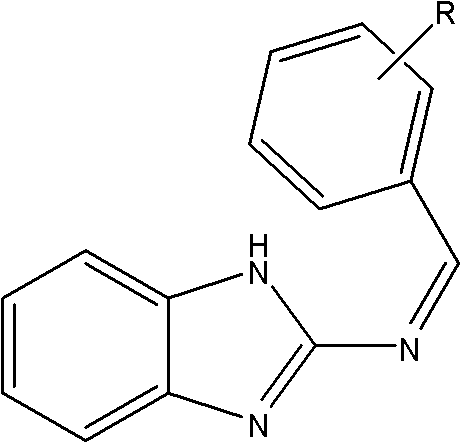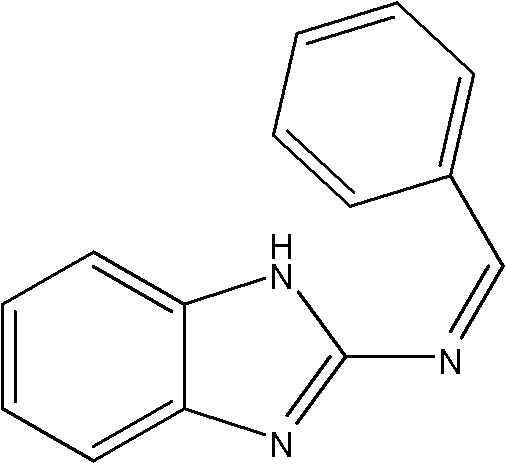Benzimidazole Schiff base and synthesis method thereof
A technology of benzimidazole and aminobenzimidazole, which is applied in the field of microwave synthesis of benzimidazole Schiff base, achieves the effects of high reaction yield, high sterilization rate and simple reaction operation
- Summary
- Abstract
- Description
- Claims
- Application Information
AI Technical Summary
Problems solved by technology
Method used
Image
Examples
Embodiment 1
[0019] Synthesis of N-Benzimidazolyl-1-phenylimine
[0020] In a 250ml three-neck flask, add 0.01mol of 2-aminobenzimidazole, 0.01mol of benzaldehyde, and 100ml of toluene, then add 0.1ml of piperidine, heat to 105°C under 400W microwave irradiation, react for 20min, and filter after cooling , washed with ethanol. Then recrystallize with ethanol to obtain the product, the product is a yellow solid, the yield: 85%. Melting point: 160-161°C.
[0021]
[0022] 1 H NMR (DMSO-d6, 300MHz): 12.67(s, 1H, NH benzimidazole ), 9.46(s, 1H, H arom ), 6.85-8.07 (m, 9H, H ring ).
[0023] IR (cm -1 ): 3054, 2759, 1666, 1565, 1480.
[0024] The bactericidal activity test shows that: when the concentration is 20ppm, the bactericidal rate of sulfate-reducing bacteria and iron bacteria reaches 92.2% and 80.2% respectively in 1 hour.
Embodiment 2
[0026] Synthesis of N-benzimidazolyl-4-fluorophenylimine.
[0027] In a 250ml three-neck flask, add 0.01mol of 2-aminobenzimidazole, 0.01mol of p-fluorobenzaldehyde, and 100ml of ethanol, then add 0.3ml of glacial acetic acid, and heat to 105°C under 100W microwave irradiation, react for 20min, and cool Then filter and wash with toluene. Then recrystallize with ethanol to obtain the product, the product is a yellow solid, the yield: 80%. Melting point: 185-186°C.
[0028]
[0029] 1 H NMR (DMSO-d6, 300MHz): 12.65 (s, 1H, NH benzimidazole ), 9.46(s, 1H, H arom ), 7.07-8.17 (m, 7H, H ring ).
[0030] IR (cm -1 ): 3065, 2753, 1615, 1587, 1461.
[0031] The bactericidal activity test showed that: when the concentration was 20ppm, the bactericidal rates of sulfate-reducing bacteria and iron bacteria reached 96.7% and 85.1% respectively in 1 hour.
Embodiment 3
[0033] Synthesis of N-Benzimidazolyl-4-methylphenylimine
[0034] In a 250ml three-neck flask, add 0.01mol of 2-aminobenzimidazole, 0.01mol of p-fluorobenzaldehyde, and 100ml of toluene, then add 0.2ml of pyridine, and heat to 115°C under 400W microwave irradiation, react for 5min, and cool Filter and wash with toluene. Then recrystallize with ethanol to obtain the product, the product is a yellow solid, the yield: 72%. Melting point: 238-239°C.
[0035]
[0036] 1 H NMR (DMSO-d6, 300MHz): 12.65 (s, 1H, NH benzimidazole ), 9.40(s, 1H, H arom ), 7.07-7.97 (m, 8H, H ring ), 2.42 (s, 3H, CH 3 ).
[0037] IR (cm -1 ): 3054, 2757, 1666, 1566, 1440.
[0038] The bactericidal activity test shows that: when the concentration is 10ppm, the bactericidal rates of sulfate-reducing bacteria and iron bacteria reach 91.3% and 80% respectively in 1 hour.
PUM
 Login to View More
Login to View More Abstract
Description
Claims
Application Information
 Login to View More
Login to View More - R&D
- Intellectual Property
- Life Sciences
- Materials
- Tech Scout
- Unparalleled Data Quality
- Higher Quality Content
- 60% Fewer Hallucinations
Browse by: Latest US Patents, China's latest patents, Technical Efficacy Thesaurus, Application Domain, Technology Topic, Popular Technical Reports.
© 2025 PatSnap. All rights reserved.Legal|Privacy policy|Modern Slavery Act Transparency Statement|Sitemap|About US| Contact US: help@patsnap.com



